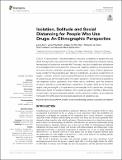Isolation, solitude and social distancing for people who use drugs : an ethnographic perspective
Abstract
COVID-19 has resulted in deepened states of crisis and vulnerability for people who use drugs throughout Europe and across the world, with social distancing measures having far-reaching implications for everyday life. Prolonged periods of isolation and solitude are acknowledged within much addiction literature as negatively impacting the experiences of those in recovery, while also causing harm to active users – many of whom depend on social contact for the purchasing and taking of substances, as well as myriad forms of support. Solitude, however, is proposed by the authors as inherent within some aspects of substance use, far from particular to the current pandemic. Certain forms of substance use engender solitary experience, even where use is predicated upon the presence of others. Adopting a cross-disciplinary perspective, this paper takes as its focus the urgent changes wrought by the pandemic upon everyday life for people who use drugs, drawing on recent ethnographic fieldwork with substance users in Scotland. Beyond the current crises, the paper proposes solitude, and by extension isolation, as an analytical framework for better apprehending lived experiences of substance use.
Citation
Roe , L , Proudfoot , J , Tay Wee Teck , J B , Irvine , R D G , Frankland , S & Baldacchino , A M 2021 , ' Isolation, solitude and social distancing for people who use drugs : an ethnographic perspective ' , Frontiers in Psychiatry , vol. 11 , 623032 . https://doi.org/10.3389/fpsyt.2020.623032
Publication
Frontiers in Psychiatry
Status
Peer reviewed
ISSN
1664-0640Type
Journal article
Description
Funding: Economic and Social Research Council (ESRC); Grant number ES/V011383/1; postdoctoral research fellowship.Collections
Items in the St Andrews Research Repository are protected by copyright, with all rights reserved, unless otherwise indicated.
Related items
Showing items related by title, author, creator and subject.
-
Strength in a weakened state : interpreting Hizb’allah’s experiences as a social movement and governing coalition in Lebanon 1985-2013
Bernhoff, Arthur (University of St Andrews, 2015-06-23) - ThesisThis study investigates Hizb’allah’s successful but competing dual development as an extra-institutional Shi’a social movement and an institutional political party. Hizb’allah has traditionally been studied from the ... -
Radical social innovations and the spatialities of grassroots activism : navigating pathways for tackling inequality and reinventing the commons
Apostolopoulou, Elia; Bormpoudakis, Dimitrios; Chatzipavlidis, Alexandros; Cortés Vázquez, Juan José; Florea, Ioana; Gearey, Mary; Levy, Julyan; Loginova, Julia; Ordner, James; Partridge, Tristan; Pizarro Choy, Alejandra; Rhoades, Hannibal; Symons, Kate; Veríssimo, Céline; Wahby, Noura (2022-04-05) - Journal articleIn this article, by drawing on empirical evidence from twelve case studies from nine countries from across the Global South and North, we ask how radical grassroots social innovations that are part of social movements and ... -
Wellbeing and social network characteristics in rural communities : findings from a cohort in social housing in Cornwall, United Kingdom
Long, Emily; Stevens, Sebastian; Topciu, Raluca; Williams, Andrew James; Taylor, Timothy; Morrissey, Karyn (2022-05-19) - Journal articleBackground: The mental wellbeing of those living in resource poor and rural localities is a public health priority. Despite evidence of a link between social networks and mental wellbeing, little is known about this ...

